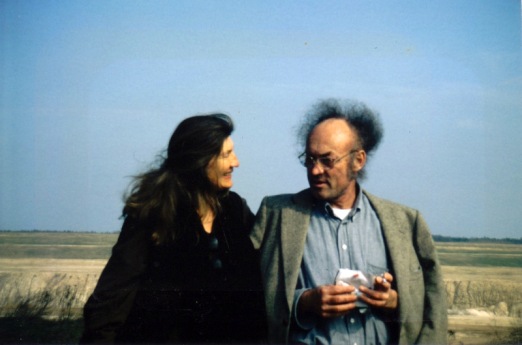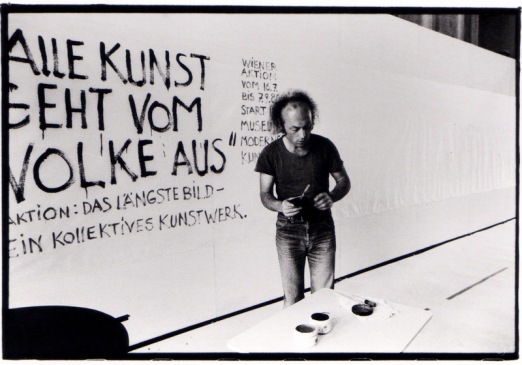Herman Prigann (Recklinghausen, 1942 – Portals Nous, 2008) zählt zu den wichtigsten zeitgenössischen Künstlern Europas. Seine Arbeit hat durch ihre wegweisende, ökologisch bewusste Richtung die Entwicklung der Landschaftskunst / Land Art wesentlich beeinflusst. Parallel dazu arbeitete er im Laufe der Jahre an einem großen malerischen Werk, in dessen Bildern sich viele der Gedanken und Ideen seiner Landschaftskunst widerspiegeln.
Der Öffentlichkeit hin zeigte er die sozial und politisch engagierte, vernetzende und kooperative Seite seiner Kunst, die ihre Wurzeln in seinen explizit intermedial ausgerichteten Happenings und Aktionen der 60ziger Jahre hat. Anfang der 80ziger Jahre bildeten seine Gedanken zu den frühen Metamorphen Objekten / Skulpturalen Orten die ersten Grundlagen für eine ökologische Ästhetik, die sich von 1985 an auch in seinen Arbeiten im öffentlichen Raum und seit Ende der 80ziger Jahre in seiner Assoziation mit der Art in Nature Bewegung, sowie bei der Rekultivierung von Industriebrachen äußerte. Mitte bis Ende der 90ziger Jahre war Herman Prigann Professor am Bauhaus in Dessau und 2003 wurde er zum Ehrenmitglied des Deutschen Werkbundes ernannt.
International bekannt wurde er durch seine innovative Landschaftskunst. Er realisierte Art in Nature Projekte u.A. in Österreich, Deutschland, Italien, Frankreich, Dänemark und Japan. Darunter Hanging Tree (1985), eine Landmarke inmitten der Wiener Stadtlandschaft, Der Ring der Erinnerung (1992-1993), ein skulpturaler Ort an der ehemaligen deutsch-deutschen Grenze im Harz und der Skulpturenwald Rheinelbe (1997-2005) – die Transformation einer Industriebrache im Ruhrgebiet – dessen größter Bestandteil, der eindrucksvolle Spiralberg mit Himmelstreppe, nicht nur Merkmal der Region geworden ist, sondern auch eines der weltweit bekanntesten Landschaftskunstwerke.
2011 widmete das Tate Modern in London seinen Jahreskalender dem Thema Land Art. Der Spiralberg mit Himmelstreppe erschien neben den Werken von Künstlern wie Robert Smithson, Richard Long und Antony Gormley. Im selben Jahr erschien New Earthwork: Art Action Agency, ein Buch des amerikanischen Verlags International Sculpture Center Press, Herausgeber des Sculpture Magazin. In dem Buch, welches einen Überblick über die Land Art Bewegung und deren wichtigsten Künstler und Werke bietet, wird auch Herman Priganns Einfluss und Arbeit eingehend beleuchtet.
Die andere Seite der Arbeit Herman Priganns stellt seine künstlerische Eigenwelt dar: Malereien, Objekte und Skulpturen, die er alleine und entfernt vom Aufwand seiner großen Landschaftskunstwerke schuf.
Es existieren jedoch tiefe Zusammenhänge zwischen diesen zwei künstlerischen Welten; sie spiegeln einander wider. Der satirische Humor und die Sozialkritik seiner Hamburger Happenings und Aktionen sind auch in den Bildern der 70ziger und frühen 80ziger Jahre präsent, z.B. in Werken wie Ehrlichmann & Haldemann (1974) oder in der Serie Die Akkurate Gesellschaft aus seiner Zeit in Wien. Ab Mitte der 80ziger Jahre beschäftigte Herman Prigann sich immer intensiver mit den Themen Natur, Wahrnehmung und Metamorphose – Konzepte, die ihren Ausdruck in seiner Landschaftskunst fanden, zuerst in Verbindung mit Art in Nature, später in der künstlerischen Umwandlung von alten Industriebrachen. Die Malereien und Objekte aus dieser Zeit reflektieren verwandte Ideen: Menschenbilder – neue Landschaften – Menschentanz – der Tanz von Entropie und Evolution – Menschen als „Ephemeroi,“ Teil eines sich stätig wiederholenden Wandlungsprozesses.
In Herman Priganns gesamten Werk treten Muster auf, Fäden die Verbindungen zwischen seiner Landschaftskunst, seiner Malerei und den Themen, die ihn seit jeher faszinierten, knüpfen. Es entsteht ein spannendes Geflecht aus Ideen und Geschichten, die von Menschen, Orten, Vergangenheit, Gegenwart und Zukunft erzählen.
Vera David (Wien, 1950 – Portals Nous, 2005), seine Lebensgefährtin und kreative Mitarbeiterin, spielte über 30 Jahre lang eine wesentliche Rolle in seinem künstlerischen Schaffen.
„Wir sind ein Pünktchen im Universum…” sagte er, „Und das einzig Sichere ist, dass alles unsicher ist.“
* * *
Herman Prigann (Recklinghausen, 1942 – Portals Nous, 2008) was among the most important contemporary artists in Europe whose forward-thinking, ecologically conscious approach significantly influenced the development of Environmental Art. At the same time, he developed a vast body of work as a painter, which reflected many of the same ideas and themes that defined his work in the landscape.
He was best known for the socially conscious, collaborative and interdisciplinary side of his art, which had its roots in the happenings and actions he developed during the 1960s. His focus first shifted to art and the environment during the early 1980s when he created his first Metamorphic Objects/Sculptural Spaces. Over the coming years, he was closely associated with the Art in Nature movement. Taken together, it formed the basis for what would eventually evolve into his theory of Ecological Aesthetics, an approach to art in environmental design that informed his work in the public space for much of his career. Most importantly, it came to define his artistic practice in reimagining and reshaping old industrial sites. From the mid-to-late 1990s, Herman Prigann was a professor at the Bauhaus in Dessau, and in 2003 he was named an honorary member of the Deutscher Werkbund (German Association of Craftsmen).
His innovative work in the landscape garnered international recognition. He realized Art in Nature projects in Austria, Germany, Italy, France, Denmark and Japan, among others. These include Hanging Tree (1985), a landmark in the middle of Vienna’s urban landscape; The Circle of Remembrance (1992–1993), a sculptural place on the former border between East and West Germany in the Harz Mountains; and the Sculptural Woods Rheinelbe (1997–2005), the full transformation of an industrial wasteland in the Ruhr Valley. The project’s central piece, the striking Spiral Hill with Sky Stairs, has not only become a regional landmark, but one of the best known landscape artworks in the world.
In 2011, the Tate Modern in London chose Land Art as the theme of its yearly calendar. The Spiral Hill with Sky Stairs appeared alongside the work of Robert Smithson, Richard Long and Antony Gormley. That same year, International Sculpture Center Press, which puts out Sculpture magazine, published New Earthwork: Art Action Agency. The book traces the evolution of art movements from Arte Povera to British Land Art and social sculpture to examine artistic approaches to ecological transformation. Herman Prigann’s work is explored alongside that of other artists like Richard Long, David Nash, Alfio Bonanno, Chris Drury, Andy Goldsworthy, Helen Mayer & Newton Harrison and Alan Sonfist.
The other facet of Herman Prigann’s work represents the interior world of the artist: paintings, objects and sculptures that he created in solitude, removed from the enormous scale and intense activity of his environmental art.
Deep connections, however, exist between these two artistic worlds. They reflect one another. The biting satire and social critique of the happenings and actions of his Hamburg period can also be found in his paintings from the 1970s and early 1980s, e.g. Ehrlichmann & Haldemann (1974) or the series Die Akkurate Gesellschaft (Accurate Society) from his Vienna period. Starting in the mid-1980s, Herman Prigann focused more intensively on the themes nature, perception and metamorphosis – concepts that were reflected in his work in the landscape, first as part of Art in Nature, then in the artistic transformation of abandoned industrial sites. The paintings and objects from this time reflect similar ideas: the human figure – new landscapes – the dance of humanity – the dance of entropy and evolution – humans as ephemeroi, part of an on-going process of transformation.
In Herman Prigann’s complete body of work, one finds patterns, threads that draw connections between his art in the landscape, his painting and the themes that fascinated him throughout his life. These ideas and stories overlap and intersect to convey a thought-provoking narrative about who and where we are – as well as where we have been and where we might be going.
Vera David (Vienna, 1950–Portals Nous, 2005), his partner in life and art, played an essential role in his creative work for over 30 years.
“We are a dot in the universe,” he said, “And the only certainty is that everything is uncertain.”
* * *
Herman Prigann (Recklinghausen, 1942 – Portals Nous, 2008) vivió una doble vida artística. Públicamente expresó la faceta de implicación social, interdisciplinaria y colaborativa de su trabajo, desde los happenings y acciones de los sesenta a los Objetos Metamórficos / Lugares Esculturales de los ochenta y noventa, hasta la idea de una Ecología Estética, que se desarrolló a través de su asociación con Art in Nature (Arte en la Naturaleza). La segunda faceta, el mundo interior de su arte, englobaba los cuadros, objetos y esculturas que creó solo. Mientras su trabajo en el paisaje incluía una logística compleja y equipos de colaboradores, esta segunda faceta marcaba un regreso a la soledad y al mundo de sus pensamientos.
Las conexiones entre estos dos mundos sin embargo, son profundas. De forma sutil, se reflejan. El humor satírico y la crítica social de los happenings y las acciones de la era-Hamburgo también están presentes en sus cuadros de los años setenta y principios de los ochenta, en trabajos como Ehrlichmann & Haldemann (1974) o en la serie Die Akkurate Gesellschaft de la época de Viena. A partir de la mitad de los años ochenta, el interés de Herman Prigann cada vez más se inclinó hacia una preocupación por temas como naturaleza, percepción, metamorfosis, y encontró expresión en su arte paisajístico, primero en conexión con Art in Nature, después, en su transformación artística de antiguos lugares industriales. Los cuadros y objetos de esta época reflejan ideas similares – ideas sobre seres humanos (Menschenbilder) – nuevos paisajes – el baile humano – el baile entre entropía y evolución – humanos como “ephemeroi,” parte de un interminable proceso de transformación.
En toda la obra de Herman Prigann, uno encuentra patrones, hilos que dibujan conexiones entre seres humanos, lugares, ideas, historias, pasado, presente y futuro.
Vera David (Viena, 1950 – Portals Nous, 2005), su compañera en la vida y en el arte, tuvo un papel fundamental en su proceso creativo durante más de 30 años.
“Somos un punto en el universo” dijo “ y la única certeza es que todo es incierto”.





Hello
Its so great to read about Herman. I thought he was a fascinating man with a fascinating mind.I always used to enjoy so much listening to his stories.
I´m not an artist my self but i do appreciate his work.
I will look forward to follow this website.
Thank you
With love
Philippa.